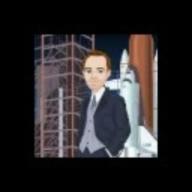After reading an Iain M Banks book recently called Excession, where there are "spaceships" that are very big - miles long - I got to thinking. How big would a man-made object in orbit have to be to cause an eclipse?
I would imagine pretty big. And presumably the farther out the orbit, the bigger it would have to be.
So let's say the closest orbit that can be sustained by gravity and a few little course corrections every now and then, wherever that is. I'm not sure if it'd be getting to the size where it'd be causing its own significant gravity as well.
And although I'd imagine a full eclipse, a partial eclipse big enough to be noticeable from Earth would be interesting also.
I'm thinking spaceships turning up like Close Encounters, causing Connecticut Yankee style eclipses. :-D Just interested, really.
How big would a spaceship have to be to cause an eclipse?
2008-08-28 4:31 pm
回答 (7)
2008-08-28 7:06 pm
✔ 最佳答案
Beach Bum is using a very simple technique called "similar triangles," which is a good, easy way to determine what size an object would need to be at any given distance to appear to your eye the same size as the Moon.To take this a bit further, you're wanting a darkness that covers an area of land, and not just one particular observer, right? Then the triangle needs to be modified so that the vertex is not one individual observer, but where the "tip" of the Moon's umbra (full shadow) would be if there were no Earth. You now need one more measurement in addition to the size of the Moon and its distance away: You need to know the size of the area of totality.
I looked up an eclipse report from Australia 2002, and from the map, I estimate that the area of totality was about 50km wide.
I'll spare you the trig I used, but I came up with a figure of 5923km is the distance from the surface of the Earth to the "tip" of the shadow cone.
So now, you use the ratio as follows:
25/5923 = x/y+5923 where x = 1/2 the size of the object and y = the distance. Let's say it's at the edge of space, 100km. To eclipse the Sun in a similar manner as the Moon does, the ship would be:
x=25x(100+5923)/5923 = 25.4km.
X is half the object's size, so that means the mothership would have to be 50.8km across at an altitude of 100km in order to black out the sun just like an eclipse, causing night-like darkness for a large area.
2008-08-28 5:05 pm
Depends on how far away it is. If it's only 3 feet away, it only has to be about the size of a 1/2 dollar. If it's 30 miles away, it has to be about the size of a city. It's it's 300 miles away, it has to be about the size of Long Island.
2008-08-28 4:46 pm
Without doing a lot of heavy math, the ratio of the moon's diameter to the moon's distance is perfect to cause solar eclipses (amazin' ain't it?). So, that same ratio is needed if an object is 10 miles across rather than 2200 miles across.
So, let's say an object is 1/10 the diameter of the moon ...instead of 2200 miles across, an object is 220 miles across...that object would need to be 10 times closer to cause an eclipse.
p.s. you math nerds, gimme a break...i'm just trying to get close enough for gummit work here.
So, let's say an object is 1/10 the diameter of the moon ...instead of 2200 miles across, an object is 220 miles across...that object would need to be 10 times closer to cause an eclipse.
p.s. you math nerds, gimme a break...i'm just trying to get close enough for gummit work here.
2008-08-28 4:55 pm
To cover the Sun, a spaceship would need to have a width about 1/100th of its distance. If we say it's 200 miles up (there aren't many satellites below that height) it would therefore have to be 2 miles wide. Satellites at that height move quite quickly across the sky, so an eclipse of the Sun would be over in less than a second.
2016-12-15 5:40 am
I fairly have been led to have faith that the reason for the massive Bang™ became a rupture interior the fabric of time and area. i'm very acquainted with all 4 of those i.e ruptures, fabric, time and area. i think 4 is greater useful than a Trinity because of the fact there is one greater. I fairly have now switched over and alter right into a great Banger™
2008-08-28 11:08 pm
I had a 747 cause an eclipse the other day, as I was on the end of the runway. I felt like calling the news, until I realized I was the only one who experienced it.
Even a solar eclipse is felt in a relatively small area, because the moons shadow is so small.
Even a solar eclipse is felt in a relatively small area, because the moons shadow is so small.
2008-08-28 7:03 pm
Any where from a couple of feet to 3,000 miles in diameter depending on it's distance from you.
收錄日期: 2021-05-03 21:39:37
原文連結 [永久失效]:
https://hk.answers.yahoo.com/question/index?qid=20080828083103AA01Fwc

